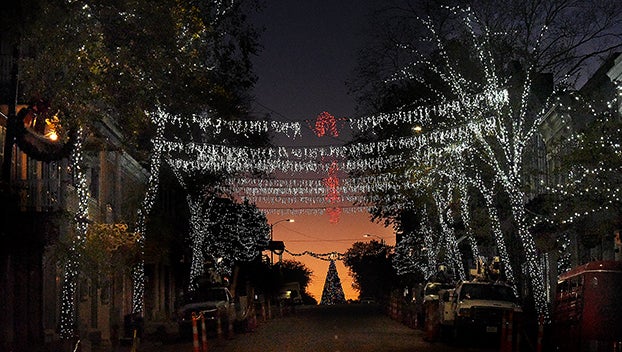New technologies used to diagnose Stanton Hall problems
Published 12:35 am Wednesday, October 26, 2011

ERIC SHELTON | THE NATCHEZ DEMOCRAT Michael P. Schuller, president of Atkinson-Noland and Associates, left, and Glenn Boornazian, of Integrated Conservation Resources based out of New York, analyze the images from the microwave radar that detects metals that could cause damage embedded in the walls of Stanton Hall.
NATCHEZ — Out-of-town rescuers have swooped in to help save a local lady from a villain that creeps in every chance it gets — water.
Stanton Hall was crawling with those knights in shining radars, also known as structural engineers, Tuesday who are employing useful technologies to diagnose problems within the house’s walls without causing more damage.
With Stanton Hall’s corners cracking and separating, and pieces of the structure literally falling to the ground, The Pilgrimage Garden Club is leading the mission, and soon a big fundraiser, to save the property.
“Water is the chief culprit where damage of historic buildings is noticed,” said Glen Boornazian, an architectural conservator from New York City.
John H. Stubbs, a preservation architect who currently teaches at Tulane, said it’s only natural that a building like Stanton Hall would need rescuing.
“This is not uncommon for a 160-year-old building that is so grand with complex design,” Stubbs said. “We’re here at a good time to see the range of problems before it gets to be an even larger job.”
Stubbs spoke on behalf of the architectural saviors, saying that of all the places they have traveled and worked in the world, it was a thrill to be in Natchez.
“It’s an honor, a pleasure to be working in Natchez on this world-class monument,” Stubbs said.
Mimi Borman of the PGC board of directors, said the club contacted former Natchez native Lawrence Adams to find the very best structural engineers for the project.
“We have one chance to get this right,” Borman said. “We don’t want to just cover up the problems. The greatest monument requires the greatest possible care and attention in our time, because we’re responsible to keep it going for future generations.”
Miller said it cost the Stanton family $85,000 to build the house in 1857.
“That was a big-time ambition,” Borman said. “The Stantons were trying to make a point.”
The architectural conservators will draw up guidelines implementing the repairs, which will be presented at a meeting of the board and fundraising committee today.
While the undertaking is forecast to be expensive, the good news for Stanton Hall is that her face need not be destroyed in the search for structural weaknesses.
Michael P. Schuller, a preservation engineer from Boulder, Colo., brought tools that penetrate Stanton Hall’s stucco without disfiguring her. He said several different technologies will be used to identify problems invisible beyond the stucco.
Schuller said one device identifies the presence of moisture and moisture patterns under surfaces. A metal detector of sorts that employs microwave radar can locate metals embedded in walls, which often corrode, leading to damage. It can also find water and voids in a wall. Infared cameras can be used as well, which paint a picture of heat patterns — the loose parts of a wall appearing cooler than sturdy parts.
Stubbs said checking the building with those tools is all part of the “getting acquainted” exercise.
“We’ll also be talking with the maintenance staff and owners to size it up,” Stubbs said. “We’ll know by mid-day (today) what the range of challenges are. And we’ll be able to present results of initial findings to outline that range, and present solutions.”
Contracts will be awarded to contractors whose work will be closely supervised.
“We’re going through this trouble, we want to make sure the solutions are addressed thoroughly,” Stubbs said. “And what works here might be applicable at other places.”






